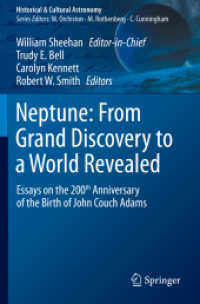Full Description
In order to feed the world, global agriculture will have to double food production by 2050. As a result, the use of soils with fertilizers and pesticides in agronomic ecosystems will increase, taking into account the sustainability of these systems and also the provision of food security. Thus, soil ecosystems, their health, and their quality are directly involved in sustainable agronomical practices, and it is important to recognize the important role of soil microbial communities such as mycorrhizal fungi, their biodiversity, interactions, and functioning. Soil ecosystems are under the threat of biodiversity loss due to an increase of cultivated areas and agronomic exploitation intensity. Also, changes in land use alter the structure and function of ecosystems where biodiversity is vital in the ecosystem.
Soils are a major aid in food production in all terrestrial ecosystems; however, this means they are also involved in gas emission and global warming.Thus, in agronomic ecosystems, several mitigation practices have been proposed to promote the increase of carbon soil stock, and the reduction of warming gas emission from soils. In South America, most of the rural population depends economically on agriculture and usually works in family units. New, organic, safe, and sustainable agro-forestry practices must be applied to support local communities and countries to achieve hunger eradication, rural poverty reduction, and sustainable development.
This book compiles new information for mycorrhizal occurrence in natural and anthropic environments in South America. It includes new reports of mycorrhizal fungi diversity along different mycorrhizal types and their effect on plant communities, plant invasions, the use of mycorrhizal fungi for ecological and sustainable studies, management programs of natural and agroecosystems, and forestry and food-secure production. This book fills the gaps in biodiversity knowledge, management and safe food production of mycorrhizas. It should be a valuable help to researchers, professors and students, to aid in use of mycorrhizal fungi while also focusing on their biodiversity, sustainable safe food production, and conservation perspectives.
Contents
1. Overview.- 2. Ectomycorrhizal fungi invasions in Southern South America.- 3. Pseudomonotes tropenbosii, an endemic Dipterocarp tree from a Neotropical terra firme forest in Colombian Amazonia that hosts ectomycorrhizal fungi.- 4. Arbuscular Mycorrhizal Fungi in the Colombian Amazon: A Historical Review.- 5. AMF diversity in coffee and cacao agroforestry systems: importance for crop productivity and forest conservation.- 6. Potential of arbuscular mycorrhizas for the remediation of soils impacted with pollutants.- 7. Diversity of Arbuscular Mycorrhizal Fungi in the Ecuadorian Amazon region..- 8. Orchid Mycorrhizas in South America: Tropical and Subtropical Ecosystems.- 9. Symbiotic propagation of South American orchids.- 10. Arbuscular mycorrhizal fungi in agroecosystems of East-Central Argentina: two agricultural practices effects on taxonomic groups.- 11. Metal soil contamination, metallophytes and arbuscular mycorrhizal fungi from South America.- 12. Native and exotic woodland from Patagonian Andes: Anthropic impacts and Mycorrhizas.- 13. Current Knowledge on Mycorrhizal Symbiosis and Endophytes in northwest Patagonia, Argentina.- 14. Mycorrhizas in Nothofagus from South America: what do we know from nursery and field experiences?.- 15. Arbuscular mycorrhizal fungi in the Espinal Ecoregion, gaps and opportunities.- 16. Edible ectomycorrhizal mushrooms in South America.- 17. Arbuscular mycorrhizal symbiosis in temperate grassland forage species of Argentina.- 18. Current trends and challenges in viticulture using arbuscular mycorrhizal fungi.- 19. Communities of Glomeromycota in the Argentine Arid Diagonal: an approach from their ecological role in grassland management and use.- 20. The current scenario of the distribution, functionality and ecosystemic role of the arbuscular mycorrhizal symbiosis in Chile.- 21. Mycorrhizas and Restoration in South America.- 22. Gaps in South American mycorrhizal biodiversity and ecosystem function research.








